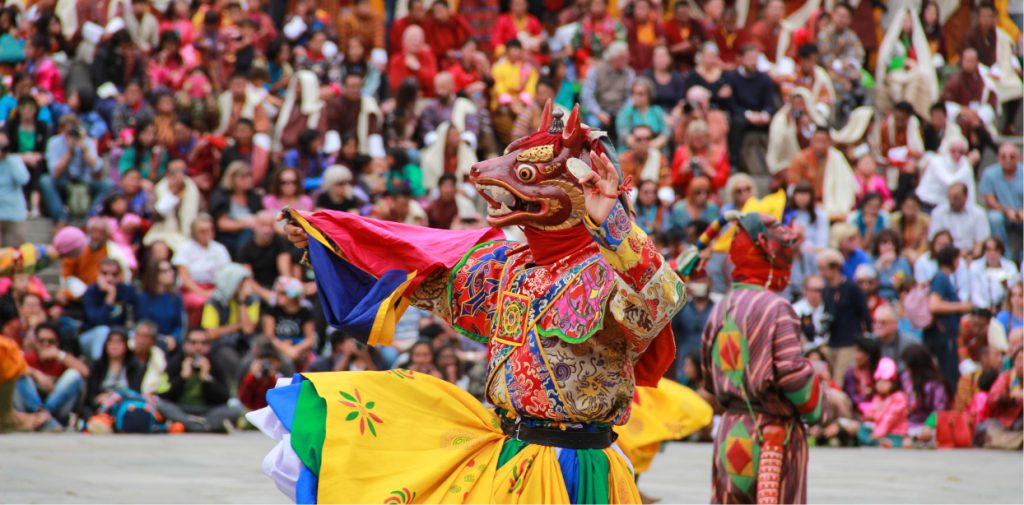
Festivals in Bhutan


Proprietor
+975 77700017
info@activebhutan.com
Festivals in Bhutan
Annual festivals called “tsechus” take place throughout the country at various periods during the year, but there are also other festivals. Tsechus are celebrations in our mountain kingdom commemorating the heroic acts of the Buddhist Saint Padmasambhava, often known as “Guru Rinpoche.”
All of Guru Rinpoche’s great actions are said to have occurred on the tenth day of the month, which is the definition of the word tsechu, and all tsechus do indeed occur on the tenth day. Annual tsechus are held in all of the districts, dzongs, and a large number of villages in the east, attracting visitors from all over.
Tsechus are celebrated for several days (typically three to five, depending on where they are held) and feature dances with well-defined religious content. Monks, laypeople, and gomchens can all perform them, and the repertory is nearly identical nationwide.
Some tsechus conclude with the worship of a massive appliqué thangkha known as a “thongdroel.” At dawn, the thongdroel is unveiled bringing enlightenment to everyone who views it. Festival goers believe that simply viewing this thongdroel will free them from the cycle of birth and reincarnation, which is Buddhism’s ultimate goal.
Some tsechu has a Wang, “wang” is a collective vocal blessing offered by a high lama to several tsechus. People are given colored threads to wear around their necks as a sign of witness to the blessing. The wang is sometimes referred to as “mewang,” which means “benediction by fire,” because it burns away their impurities. Clowns known as atsaras are known for their expressive masks and postures, which are an essential part of any religious ceremony. When the religious dances become tedious, they challenge the monks, make lewd comments, and divert the crowd with their antics. They are the only persons allowed to parody religion in a society where sacred topics are regarded with the utmost care, and they are thought to represent Acharyas, India’s religious leaders. These popular entertainers are given the opportunity to express a formulaic challenge inside a defined framework that does not disrupt the social or religious order for a few days. Some religious festivals have only a few dances and are primarily readings from a specific text.
Villagers gather in a temple on these days to partake in prayers while also imbibing powerful alcoholic beverages. Every town is proud of its yearly religious festivals, and any villagers who have moved to the city are expected to return home for them. These villagers will cover a significant portion of the festival’s expenses.
Attending religious festivals allows Bhutanese to immerse themselves in the meaning of their faith and achieve a great deal of merit. Festivals are also occasions for meeting new people and being seen by old ones, for social interactions, and for displaying success. Picnics with plenty of booze and meat are popular, and people wear their best outfits and wear their most exquisite jewellery. Men and women make fun of each other and flirt with one another. There’s a friendly, slightly ribald sense of humour in the air.
Must attend festivals Bhutan
During the winter months, many local village festivals are organised. At this time of year, the weather in Bhutan is extremely settled. The beautiful blue skies and clean air provide excellent photographic opportunities, particularly for those using slide film. A winter trip to eastern Bhutan, along with
Undoubtedly, one of the largest events in Bhutan’s capital, Thimphu, is Thimphu Tsechu. This festival, which is held every year in the fall and lasts for three to four days, is a colourful celebration that brings together the diverse emotions of Bhutanese culture and the changing seasons of nature. Cultural Tour in Bhutan.The display of ethnic folk dancing at Thimphu’s renowned Tashichho Dzong is the festival’s centrepiece. The stage for these performances, which are distinguished by colourful masks with traditional designs, is the Dzongs courtyard. Thimphu Tsechu, which is essentially a religious celebration, is significant to the Bhutanese population, who congregate in the streets of Thimphu during that time of the year.
Since the 17th century, Bhutan has celebrated Paro Tsechu, one of the most well-known religious dance festivals in the country. The skilled monks and laypeople who are dressed in incredible masks and costumes perform dances at the event in a wonderful manner. The celebration not only gave tourists a chance to witness Bhutan’s ancient living culture, but it also had religious significance for the Bhutanese people.
Guru Rinpoche, the saint who introduced Buddhism to Bhutan, is honored at the five-day event. The entire event draws attention, but the unfolding of the silk Thangka, which is considered one of the most sacred blessings when done, is something that one shouldn’t miss out on seeing. On the last day of the festival, the Thangka, also known as “thongdroel,” is a holy image scroll that is only on display for a short period of time during the day so that visitors can receive blessings.
The event lasts for five days, and each day includes unique offerings that include various activities. The first day is when the festival’s pre-rituals are performed. Inside the Paro Dzong, the monks begin their performances on the second day. The event will continue over the next three days with performances by monks and other participants in various dances and plays, which will be a breathtaking sight to see. Additionally, visitors to the Paro Tshechu can enjoy the sounds of trumpets, flutes, and cymbals as well as triumphal performances that contrast virtue with evil. People wear traditional attire throughout these five holy days.
